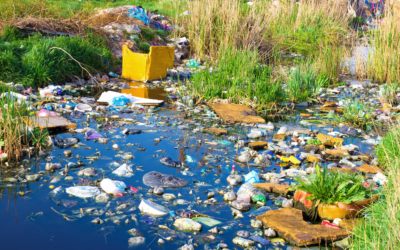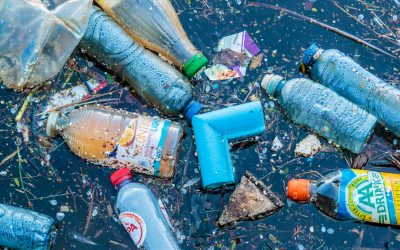By Anne Marieke Eveleens
Plastic pollution is a major threat to all water systems worldwide, causing harm to both human and animal life. Therefore, it’s crucial to clean waterways from plastic. During these clean-up efforts, the local waterway’s flora and fauna should be protected as much as possible. The Great Bubble Barrier uses air bubbles to catch plastic pollution in waterways. In this whitepaper, we delve into the question of how the bubbles impact fish.
There are around 35,000[1] different species of fish, each with their own physical characteristics and behaviour. Even within a species, individual fish can exhibit distinct character traits.[2] Making a general statement about how ‘fish’ react to bubbles is, therefore, impossible. In this paper, we will explore current knowledge on the behaviour of fish close to bubble curtains. We explain why we think the Bubble Barrier does more good than harm – for the environment and aquatic life in particular.
A short history of the Bubble Barrier system
The Great Bubble Barrier was born of an ambition to contribute to cleaner oceans. As a large part of all marine plastics is transported via rivers[3], we sought a solution to catch the plastic waste close to the source. To ensure our system would be suitable for many different types of waterways it was critical that ships and fish could pass freely. The idea of the Bubble Barrier was born.
Bubble curtains are no recent invention. This technique is already being applied to block saltwater intrusion, reduce underwater sound pollution, fight oil spills and guide fish away from rakes or water intake structures, such as those close to water treatment works or power stations. That said, our Bubble Barrier is the first bubble curtain with the goal of catching as much plastic pollution as possible, while avoiding any negative impact on the environment.
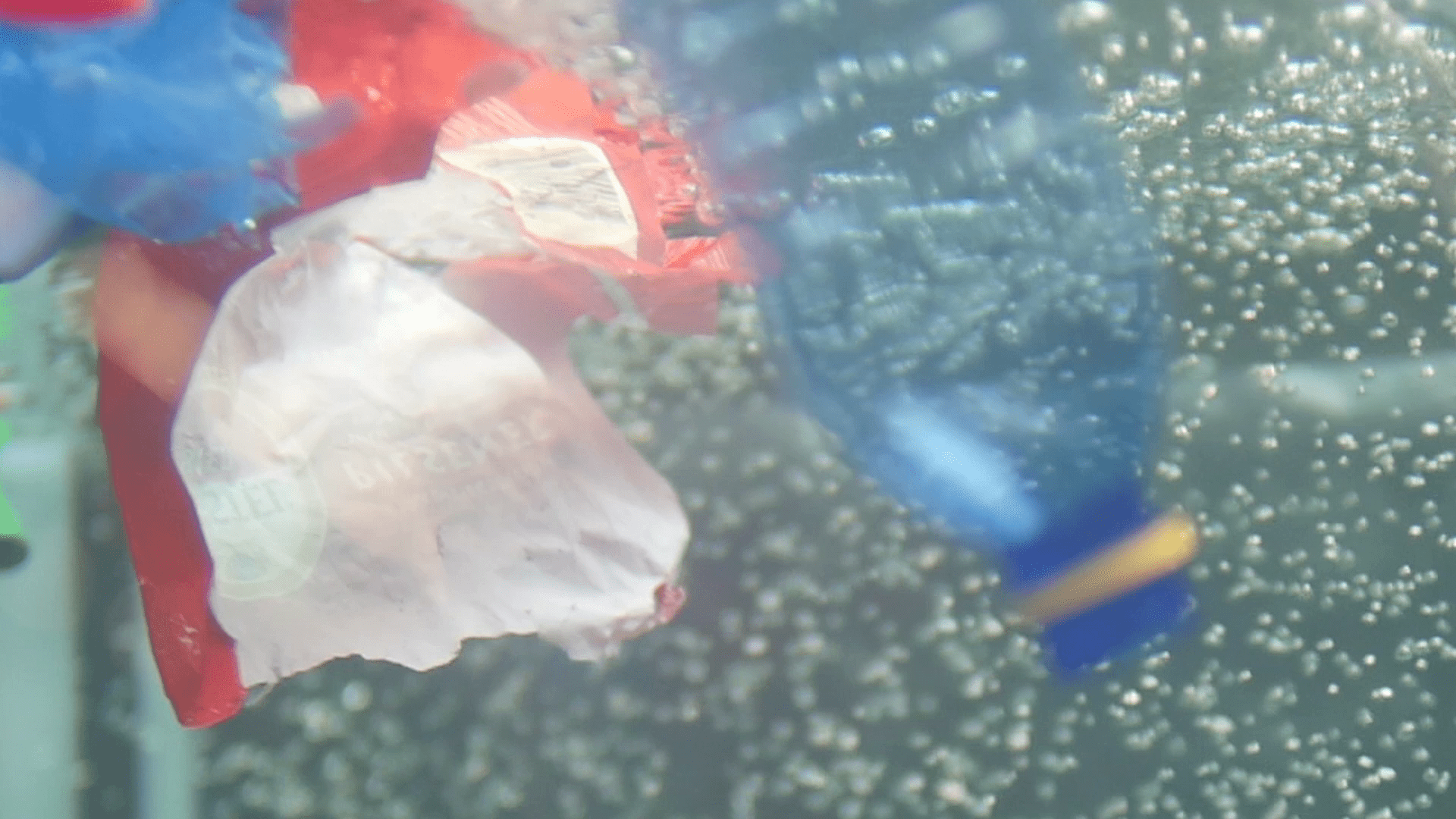
Whales’ bubble-net feeding
The ‘bubble-net feeding’ technique of humpback whales has given rise to many fascinating videos, but scientific research on the impact of the bubbles on fish is still in its infancy. Several scientific articles suggest that it is the combination of bubbles with the (very loud) noise that whales make while hunting that makes the fish stay within the ‘net’ of bubbles. The sound gets trapped between the bubbles, making the outside of the cylinder – or spiral-shaped net – noisy, while the core remains relatively quiet.[4] In contrast, our Bubble Barrier technology is anchored to the bottom of a river or canal in a diagonal line. There is no surprise attack or loud noise as there is with bubble-net-feeding whales.
Fish diversion
Most research into the behaviour of fishes close to bubble curtains has focused on their role in deflecting or diverting fish. Studied applications set out to deflect fish approaching hazardous constructions, such as pumping stations or water-cooling inlets. Such fish diversion applications are considered successful if no fish pass the bubble curtain. Our goal is entirely the opposite: we want fish to continue their natural behaviour, regardless of the presence of our Bubble Barrier.
Various studies have shown that a bubble curtain is hardly effective against diverting fish. Bubble curtains are only effective at influencing fish behaviour if additional sound and/or (strobe) lighting are used[5], thus mimicking the bubble-sound combination employed by whales. Additionally, large volumes of air are needed.[6] Alongside extra stimuli, the velocity and temperature of the water flow[7] can also impact the efficacy of these systems. This reversed burden of proof means that fish experts who have worked with bubble curtains specifically designed for fish deflection aren’t convinced of their efficacy in influencing fish migration patterns.
While whales use their bubble corralling technique to catch herring, a species that is known to school together in case of danger, research shows that smaller groups or individual herring are more inclined to swim through a curtain of bubbles than big schools.[8]
More generally, whether a fish will swim through a bubble curtain is highly dependent on its swimming capacity. The success of a diversionary bubble curtain varies by location, season, species, and the stage of life of the fish trying to pass.[9]
Our Bubble Barriers are designed to stop as much plastic as possible with the least amount of air possible. It is a single curtain, in contrast to some fish deflection systems that may have as many as six curtains in a row.[10] Bubble Barriers have no additional stimuli, such as light or sound, incorporated into the design. Therefore, the set-up differs markedly from the type of bubble curtains used for fish deflection.
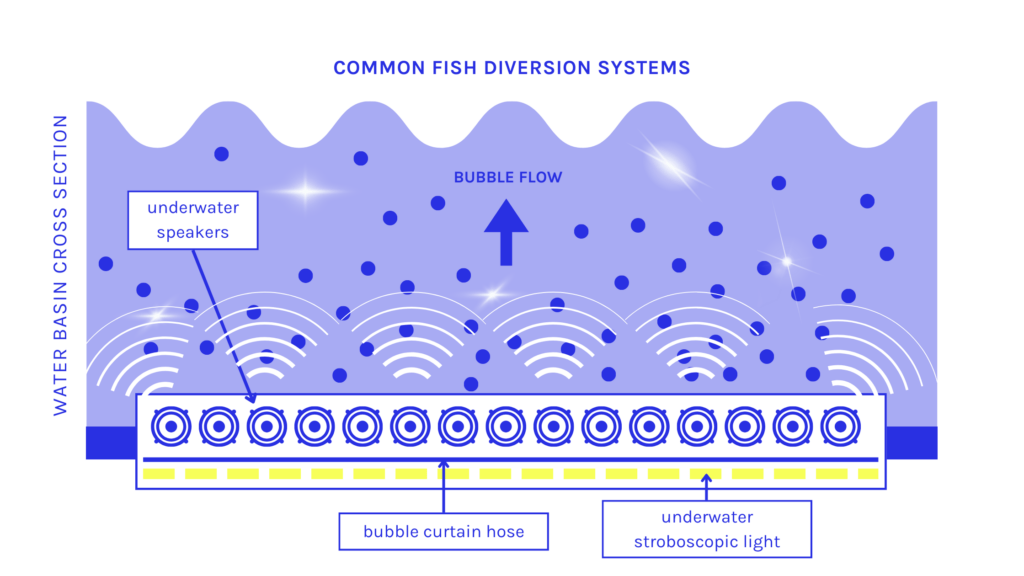
When evaluating new sites for potential Bubble Barrier installations, a key aspect we consider is the predominant or significant fish species in the local population, and what we know about how they respond to our bubbles. Additionally, we continuously investigate the latest available research and collaborate with leading ecologists during projects. The more we know, the better equipped we are to mitigate any risk.
Risk mitigation
It is important for fish not to wait in front of a bubble curtain or any other human-made obstruction for too long as it can increase their risk of being preyed upon. Additionally, when the fish do not move away from obstructions timely, it can cause behavioural changes. Any barrier could affect volumes of migrating fish which, in the worst case, would mean that they miss the opportunity to reproduce. Fortunately, literature shows that many fish rapidly become accustomed to the increase in air bubbles following the installation of a bubble curtain and once accustomed, will begin to pass back and forth through the curtain.[11]
The ability of fish to pass through a bubble curtain depends on their swimming capacity. Our Bubble Barrier is designed to direct plastics to the surface and then off to the side into our catchment system. Juvenile fish could be guided in the same direction. Any sudden upward movement could be temporarily disorientating, while in some cases the change in pressure could affect the swim bladder and result in a barotrauma.[13] This has not yet been observed with the type of bubble curtains that we use in our Bubble Barrier system. Our experience, however, is that fish that have been guided toward the catchment system are able to swim away. By contrast with plastic, fish have the ability to change directions and can escape the catchment system.
Passage without bubbles
Although multiple factors indicate that fish can pass through the Bubble Barrier without issue, we have taken extra measures to mitigate any potential problems. These mitigation measures have been designed in consultation with fish migration experts. Firstly, the Bubble Barrier system has a section without bubbles underneath its catchment system on one side of the riverbank. Secondly, we can implement an opt-out segment on the opposite riverbank upon request, which we can switch off when we anticipate fish migration. According to fish migration experts, a space of at least 1 metre from the riverbank should be enough for fish to pass through while also ensuring plastic is caught.
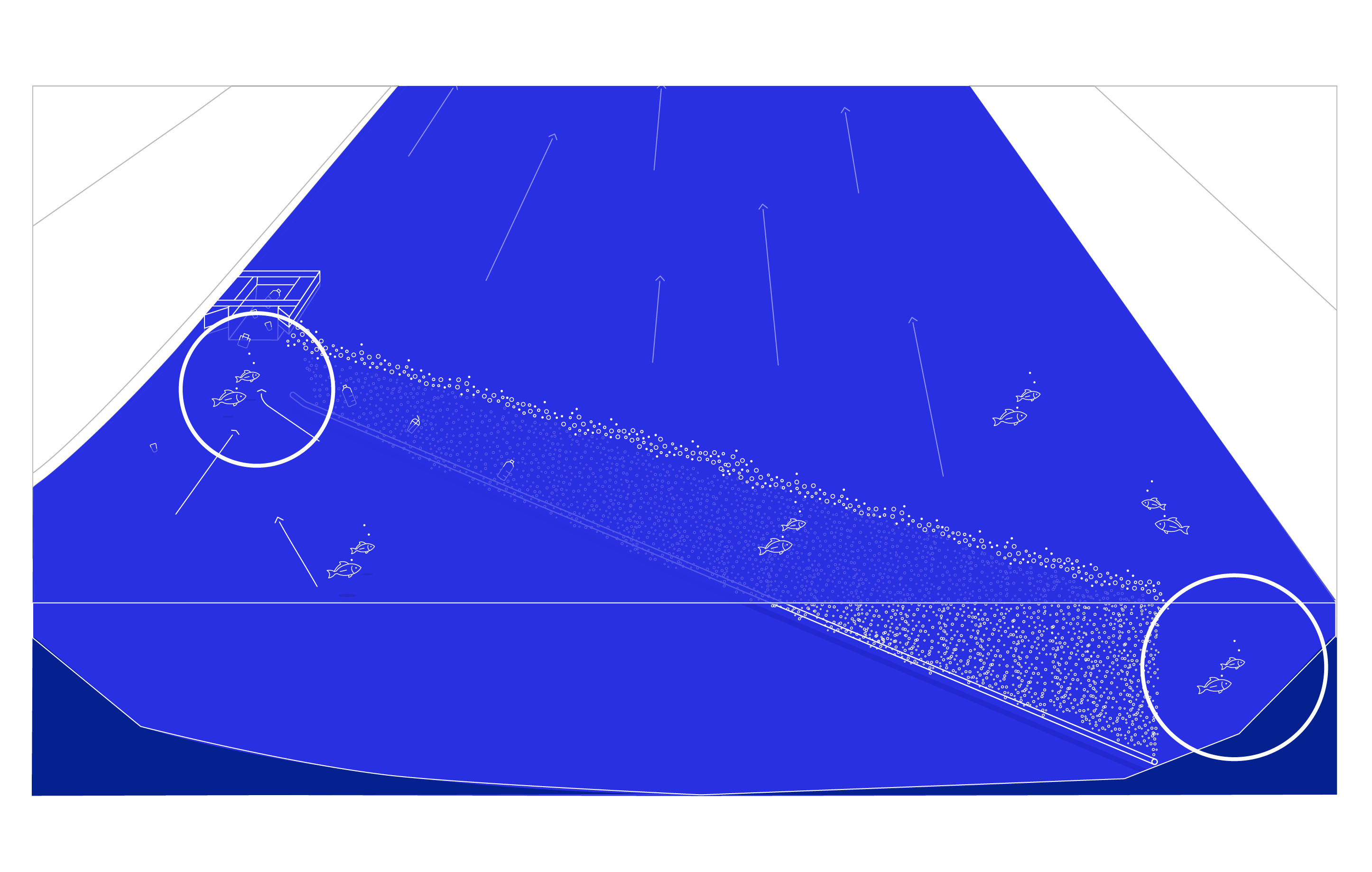
Addressing the impact of plastic pollution on ecosystems
Plastic pollution in both fresh and saltwater causes severe ecological harm to the environment, and its effects can extend far beyond its initial location. The Great Bubble Barrier team works daily towards reducing plastic pollution in aquatic environments. By cleaning plastic pollution from the environment close to the source, the Bubble Barrier technology addresses the impact of plastic pollution on ecosystems early on and prevents it from worsening.
Greenhouse gas emissions
From the moment that plastic enters the water, it harms the environment. Exposure to sunlight causes plastic to break down and emit greenhouse gasses, such as methane and ethylene.[14]
Spread of toxins
Small toxic particles can easily adhere to the surface of plastics. Once in the water, plastics can travel great distances and even cross oceans taking those particles with them. This can spread persistent pollutants, invasive species, and diseases.[15]
Entanglement and starvation of wildlife
Plastics have a significant impact on wildlife, especially aquatic mammals, fish, turtles, and birds.[16] They face the risk of getting entangled or dying of starvation after consuming large amounts of plastic.[17] Even a single plastic bag can be fatal for a mammal as large as a whale shark.
Microplastics and aquatic fauna
The longer plastic stays in the water, the more brittle it becomes and the more it disintegrates into smaller pieces, called microplastics. These microplastics are found throughout the food chain, from zooplankton to the fish we humans eat. We have only just started mapping out the effects of this virtually invisible pollution on humans, animals, and the environment. However, various studies have already shown that (micro)plastics can cause health problems and even behavioural changes in marine fauna, including brain damage and behavioural disorders in fish and birds.[18],[19],[20],[21]
Secondary benefits of a Bubble Barrier
While the main purpose of a Bubble Barrier is to capture plastics in waterways, several secondary benefits have been identified.
Increased levels of oxygen
The Bubble Barrier can increase the level of dissolved oxygen in water, which can have positive effects on the local ecology. Firstly, the bubbles force the water to circulate, clarifying and de-stratifying it. Secondly, Bubble Barriers produce tiny bubbles which efficiently transfer oxygen into the water, aerating the sedimentary level and allowing naturally occurring aerobic bacteria to produce enzymes which break down and decompose waste and sediment made of organic matter.[22] The Bubble Barrier can thereby support the equilibrium in the system and help to prevent toxic algal blooms. Next to providing oxygen to the bacterial ecosystem, the Bubble Barrier provides oxygen as well for fish, invertebrates, and microbes, further supporting the ecosystem. The results from a case study performed at Bubble Barrier Amsterdam on the effects of the system on oxygenation can be found here.
Decreasing saltwater intrusion
Bubble curtains have been effectively implemented globally to halt saltwater intrusion in freshwater environments. The bubbles act as a barrier between the denser saltwater and less dense freshwater. The results from a case study performed at Bubble Barrier Amsterdam on the effects of the system on preventing saltwater intrusion in freshwater can be found here.
Noise reduction and fish
Previous sound measurements at the pilot Bubble Barrier in the Dutch River Ijssel have shown that the bubble curtain reduces the noise of passing ships. Most fish species are sensitive to sound waves. The noise from ships can negatively impact their ability to communicate, among other things. The installation of a Bubble Barrier could assist in quieting down the surrounding environments of fish.[23]
Concluding: the Bubble Barrier system has many benefits that assist in cleaning and protecting the local environment it is placed in. The closer to the source plastic pollution is removed, the greater the downstream ecological benefits will be. Besides capturing plastic, additional benefits of using the Bubble Barrier system include increasing oxygenation, reducing saltwater intrusion, and reducing underwater noise.

Author
Anne Marieke Eveleens
Anne Marieke is Co-Founder & Chief Scientific Officer at The Great Bubble Barrier. She holds an M.Sc. in Neurobiology and has extensive experience applying her scientific background to interdisciplinary challenges bridging science & society.
References
[1] Ron Fricke, R; Eschmeyer, W.N., & Fong, J.D. (2020). Species by family/subfamily in Eschmeyer’s Catalog of Fishes, California Academy of Sciences, http://researcharchive.calacademy.org/research/ichthyology/catalog/SpeciesByFamily.asp
[2] Balcombe, J. (2016). What a fish knows: The inner lives of our underwater cousins. Scientific American/Farrar, Straus and Giroux.
[3] Lebreton et al., Nat. commun. 8, 15611 (2017). River plastic emissions to the world’s oceans
[4] Leighton, T. G., Richards, S. D., & White, P. R. (2004). Trapped within a wall of sound. Acoustics Bulletin, 29, 24-29; Leighton, T. G., Finfer, D. C., Grover, E., et al., (2007). Spiral bubble nets of humpback whales: An acoustic mechanism. In Proc. 2nd Int. Conf. on Underwater Acoustic Measurements, Technologies and Results (pp. 583-588); Leighton, T. G., White, P. R., & Finfer, D. C. (2008). Hypotheses regarding exploitation of bubble acoustics by cetaceans. Journal of the Acoustical Society of America, 123(5), 3104.
[5] Zielinski, D.P., & Sorensen, P. W. (2016). Bubble curtain deflection screen diverts the movement of both Asian and common carp. North American Journal of Fisheries Management, 36(2), 267-276; Kroes, M. J., de Boer, M. B. E., Bruijs, M. C. M. et al., (2013). Onderzoek naar viswering en visgeleiding bij 7 gemalen in Nederland (met bijdragen van MCM Bruijs en HV Winter). Tauw; Turnpenny (2005).
[6] Turnpenny (2005); Zielinski (2016).
[7] Hanson, C. H., White, J. R., & Li, H. W. (1977). Entrapment and impingement of fishes by power plant cooling-water intakes: an overview. Marine Fishes Review, 39(10), 7-17.
[8] Sharpe, F. A., & Dill, L. M. (1997). The behaviour of Pacific herring schools in response to artificial humpback whale bubbles. Canadian Journal of Zoology, 75(5), 725-730.
[9] Martin, N., Leighton, T., White, P., & Kemp, P. (2021). The response of common carp (Cyprinus carpio) to insonified bubble curtains. The Journal of the Acoustical Society of America, 150 5, 3874. https://doi.org/10.1121/10.0006972.
[10] Zielinski, D. P., & Sorensen, P. W. (2015). Field test of a bubble curtain deterrent system for common carp. Fisheries Management and Ecology, 22(2), 181-184.
[11] Turnpenny, A. W. H., & O’Keeffe, N. (2005). Screening for intake and outfalls: a best practice guide. Environment Agency Science Report SC030231, Environment Agency, London, UK.
[13] Zielinski, D., Voller, V., Svendsen, J., Hondzo, M., Mensinger, A., & Sorensen, P. (2014). Laboratory experiments demonstrate that bubble curtains can effectively inhibit movement of common carp. Ecological Engineering, 67, 95-103. https://doi.org/10.1016/J.ECOLENG.2014.03.003.
[14] Royer, S. J., Ferron, S., Wilson, S. T., et al (2018). Production of methane and ethylene from plastic in the environment. PLoS One, 13(8), e0200574.
[15] Kirstein et al., (2016). Dangerous hitchhikers? Evidence for potentially pathogenic Vibrio spp. on microplastic particles. Marine Environmental Research 120, 1-8
[16] Susanti, N & Mardiastuti, Ani & Wardiatno, Yusli. (2020). Microplastics and the Impact of Plastic on Wildlife: A Literature Review. IOP Conference Series: Earth and Environmental Science. 528. 012013. 10.1088/1755-1315/528/1/012013.
[17] Germanov, E., Marshall, A., Hendrawan, I., Admiraal, R., Admiraal, R., Rohner, C., Argeswara, J., Wulandari, R., Himawan, M., Loneragan, N., & Loneragan, N. (2019). Microplastics on the Menu: Plastics Pollute Indonesian Manta Ray and Whale Shark Feeding Grounds. Frontiers in Marine Science, 6. https://doi.org/10.3389/fmars.2019.00679.
[18] Mattsson, K., Johnson, E. V., Malmendal, A., et al., (2017). Brain damage and behavioural disorders in fish induced by plastic nanoparticles delivered through the food chain. Scientific Reports, 7(1), 1-7;
[19] Tosetto, L., Brown, C., & Williamson, J. E. (2016). Microplastics on beaches: ingestion and behavioural consequences for beachhoppers. Marine biology, 163(10), 199;
[20] Clark, J. R., Cole, M., Lindeque, P. K., et al (2016). Marine microplastic debris: a targeted plan for understanding and quantifying interactions with marine life. Frontiers in Ecology and the Environment, 14(6), 317-324;
[21] Seuront, L. (2018). Microplastic leachates impair behavioural vigilance and predator avoidance in a temperate intertidal gastropod. Biology letters, 14(11), 20180453.
[22] Cong, H., Huang, T., & Chai, B. (2011). Water-Circulating Aerator: Optimizing Structure and Predicting Water Flow Rate and Oxygen Transfer. Journal of Hydraulic Engineering, 137, 659-667. https://doi.org/10.1061/(ASCE)HY.1943-7900.0000351.
[23] Würsig, B., Greene Jr, C. R., & Jefferson, T. A. (2000). Development of an air bubble curtain to reduce underwater noise of percussive piling. Marine environmental research, 49(1), 79-93.

